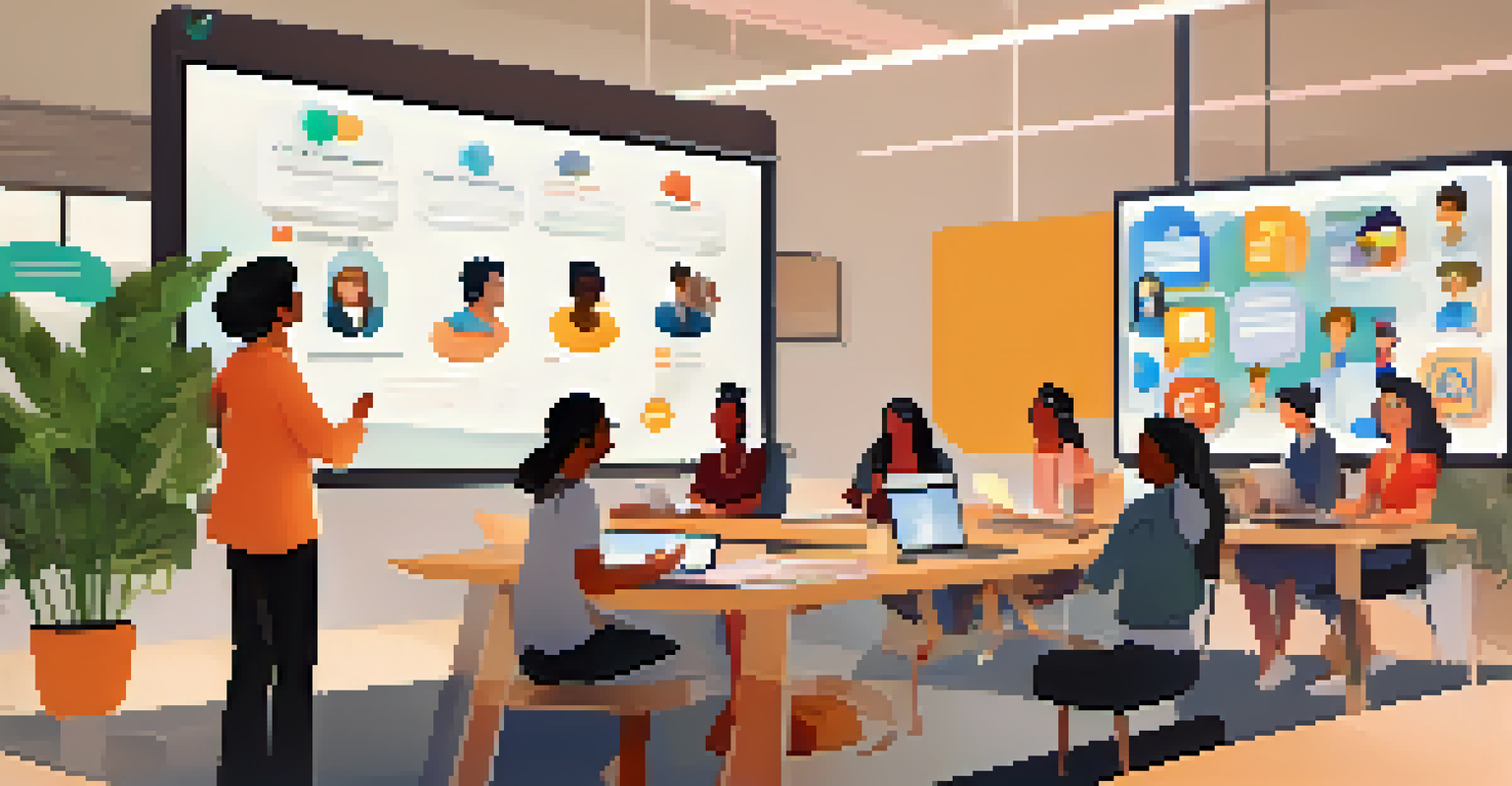Building Mobile Learning Communities: Fostering Peer Interaction

Understanding Mobile Learning Communities and Their Benefits
Mobile learning communities are digital spaces where learners connect, share, and collaborate using mobile technology. These communities harness the power of social interaction to enhance the learning experience, making education more accessible and engaging. The benefits include increased motivation, improved knowledge retention, and a sense of belonging among learners.
The great aim of education is not knowledge but action.
In these communities, learners can access resources and support anytime, anywhere, breaking the constraints of traditional learning environments. This flexibility encourages participation from diverse groups, enriching discussions with varied perspectives. Moreover, the integration of technology fosters innovative learning methods, making education more relevant to today's fast-paced world.
By facilitating peer interaction, mobile learning communities can also help reduce feelings of isolation in online learning. When learners engage with one another, they create a supportive network that encourages collaboration and shared problem-solving. This sense of community can be particularly beneficial for learners who may struggle with self-motivation or confidence.
Creating an Inclusive Environment for All Learners
Inclusivity is key when building mobile learning communities. It’s essential to ensure that all learners feel welcome and valued, regardless of their background or learning style. This can be achieved by promoting diverse participation and ensuring that resources are accessible to everyone.

To create an inclusive environment, consider using various communication tools that cater to different preferences. For example, some learners may feel more comfortable sharing their thoughts through voice messages, while others may prefer text-based discussions. By offering multiple ways to interact, you can accommodate various learning styles and comfort levels.
Benefits of Mobile Learning Communities
Mobile learning communities enhance education through increased motivation, improved knowledge retention, and a sense of belonging.
Additionally, setting clear guidelines and expectations for respectful communication can help foster a culture of inclusivity. Encourage members to share their experiences and perspectives, and celebrate the diversity within the community. When learners feel that their voices matter, they are more likely to engage actively and contribute meaningfully.
Utilizing Technology to Facilitate Interaction
Technology plays a vital role in enhancing peer interaction within mobile learning communities. Various platforms, such as discussion forums, messaging apps, and collaborative tools, can help facilitate communication and collaboration. Choosing the right tools can make a significant difference in how learners engage with one another.
Learning never exhausts the mind.
For instance, using video conferencing tools allows for real-time discussions, mimicking the experience of face-to-face interactions. This can be especially useful for group projects or study sessions, where visual cues and body language enhance understanding. Moreover, incorporating multimedia elements like videos and podcasts can spark discussions and provide rich content for learners to explore.
Additionally, leveraging gamification elements can encourage participation and interaction. By incorporating challenges, rewards, or leaderboards, you can motivate learners to engage more actively with their peers. This not only makes learning more enjoyable but also fosters a sense of community among participants.
Encouraging Active Participation and Engagement
To build a thriving mobile learning community, it's essential to encourage active participation from all members. One way to do this is by initiating discussions on relevant topics and inviting learners to share their insights. Open-ended questions can stimulate conversation and prompt deeper engagement.
Creating opportunities for collaborative projects can also foster interaction. Group assignments or peer review sessions encourage learners to work together, share feedback, and learn from one another. This collaboration not only enhances learning outcomes but also builds strong relationships among community members.
Creating an Inclusive Learning Space
Fostering inclusivity in mobile learning communities ensures all learners feel valued, encouraging diverse participation and collaboration.
Furthermore, recognizing and celebrating contributions can boost motivation and engagement. Whether it’s highlighting a member's insightful post or showcasing a successful group project, acknowledging efforts reinforces a sense of belonging. When learners feel appreciated, they are more likely to participate actively in the community.
Leveraging Social Media for Community Building
Social media can be a powerful tool for building mobile learning communities. Platforms like Facebook, LinkedIn, or dedicated apps can create informal spaces where learners connect and interact outside of formal learning environments. These platforms allow for spontaneous discussions and sharing of resources.
By creating private groups or pages, educators can foster a safe space for learners to engage without the pressure of formal assessments. Members can share articles, ask questions, and collaborate on projects, enhancing the overall learning experience. This informal setting can also help break down barriers and promote open communication.
Moreover, social media offers a wealth of resources that can enrich the learning experience. Members can easily share relevant content, such as articles, videos, or podcasts, broadening the scope of learning. By encouraging learners to contribute to the community's knowledge base, you can create a dynamic and engaging environment.
Establishing Clear Communication Guidelines
Effective communication is crucial for the success of any mobile learning community. Establishing clear guidelines can help ensure that interactions remain respectful, constructive, and focused on learning. These guidelines should be communicated from the outset to set expectations for all members.
Encouraging active listening and respectful discourse can help create a positive atmosphere. Remind members to be open to different viewpoints and to approach discussions with empathy. This not only enhances learning but also fosters a sense of community where all voices are valued.
Importance of Clear Communication
Establishing clear communication guidelines is essential for maintaining respectful and constructive interactions within the community.
Additionally, setting boundaries around topics and types of communication can help prevent misunderstandings. For instance, while it's important to encourage robust discussions, it's equally vital to maintain a focus on educational content. Clear guidelines will help keep conversations productive and aligned with the community's goals.
Evaluating and Adapting the Community Over Time
Building a mobile learning community is an ongoing process that requires regular evaluation and adaptation. Gathering feedback from participants can provide valuable insights into what’s working and what needs improvement. Surveys, polls, or informal check-ins can help gauge member satisfaction and engagement levels.
Based on feedback, it’s important to be willing to adapt the community's structure, tools, or activities. For example, if members express a desire for more collaborative projects, consider introducing more group assignments. Flexibility is key to ensuring that the community continues to meet the evolving needs of its members.

Additionally, celebrating milestones and successes can help maintain enthusiasm and motivation. Whether it’s recognizing the completion of a course or celebrating a significant number of active participants, these moments can reinforce the sense of community. By consistently evaluating and adapting, you can create a vibrant and engaging mobile learning environment.